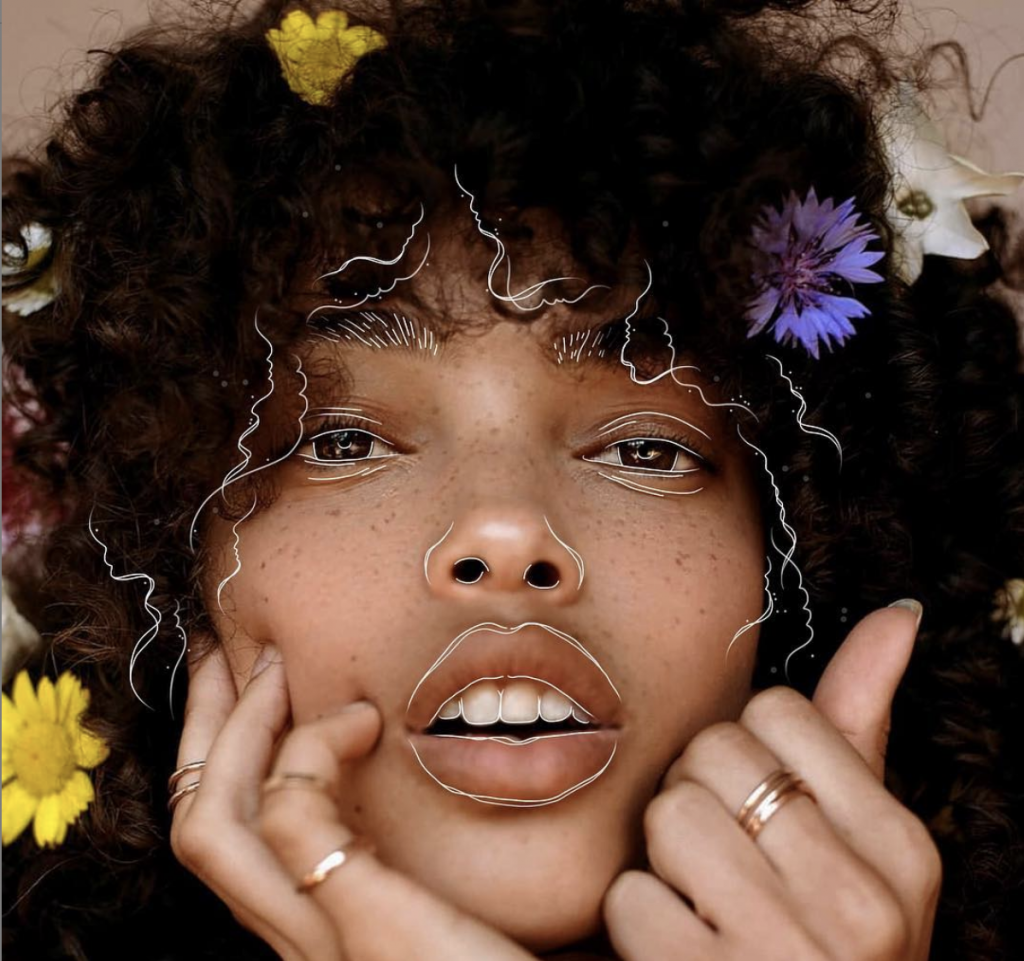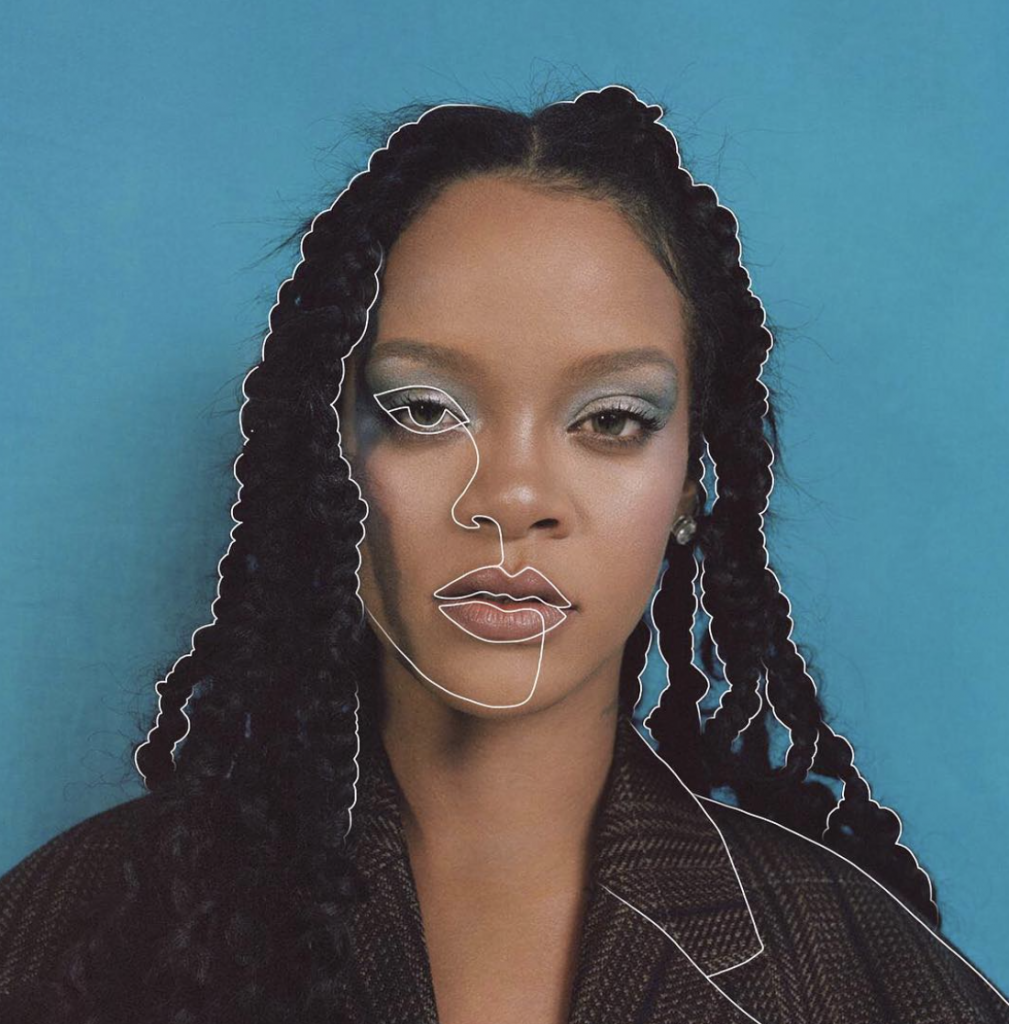Sick of reading interviews with the same Instagram influencers over and over? Same. Here’s something fresher to inspire you—Real Girls Doing Cool Shit. It’s exactly what you think: an interview with a young Aussie woman just like you, telling us about the very cool, impactful stuff she’s creating and the issues she is most passionate about. Read, get inspired, do the things.
You might not know Emma Regolini’s name, but you’ve probably seen her work. She is the digital artist behind the fresh, flossy images of Instagram art account theline_.
But as Emma explains to me here, there is a lot more to it than just lines on a photograph. Her work is a study in total digital savvy, aesthetic enhancement and what makes people double-tap.
Plus, she’s passionate about using her work to challenge the beauty norms of the luxury industry—not a small task.
Emma gave this sharp Real Girls Going Cool Shit interview with me just before moving to London, where she’s planning to take her work to the next level… Proof that, sometimes, you just need to go do the thing!

Emma Regolini, Digital Artist
Zee Feed: How do you describe your work?
Emma Regolini: It’s digital design, but it’s a bit easier if I say that I’m a digital artist. When people ask what my work is like, I say that I creatively enhance imagery, which sounds a bit nicer than “I draw lines on pictures that I like”.
ZF: How did you come to start theline_?
ER: I was working on a packaging rebranding study for a WA-based client, [in the] Luxury Branding Research Cluster at Curtin University. I had to re-create three variations of packaging for a product and basically just learnt Photoshop there and then. I was also really uninspired by my degree at the time, a Marketing and Advertising double major, so thought I would play around with a case study idea of my own.
When I first started theline_ I wanted to understand how young people and millennial audiences interacted with visual media, and if their behaviour towards imagery changed if it was aesthetically enhanced with lines or artistic expression. From there, I wanted to see if brands could enhance their imagery to boost engagement. Understanding those consumption patterns was really interesting to me. I enjoy exploring the analytical side of what makes someone double tap, comment, or re-post an image.
ZF: Tell us about your artistic process—how do you create those surprisingly soothing images?
ER: I generally just pull up a recent image that from the ‘Saved’ section of my Insta account or find something that I’ve been wanting to work on for a while but never had the right concept for.
A lot of people ask which app I use to do the lines, but really it’s just having a very steady hand on my drawing tablet. I’ve had a lot of time to refine and experiment with different line styles and formats. With the images themselves, depending on the overall nature of the image or the angles of a face or body, I really try to accentuate certain features or move with the direction of the piece when adding lines.
ZF: So, what does the practical day-to-day of being a young female ‘artist’ actually look like?
ER: I generally try to start my days with exercise, like a coastal run or morning swim, and coffee. Because theline_ is just a side project, despite having other work due for clients I still work other casual jobs, which consume the majority of my days. However, a busy week of design-based work often consists of emails, follow up emails, confirming final design mock-ups and trying to get outside to get some fresh air.
My weekends look very similar, juggling casual jobs and design deadlines, however they always finish with friends and a gin and tonic at Si Paradiso!

ZF: What are some of the biggest challenges you’ve faced while building up your work for theline_ and it’s social following?
ER: I get creative blocks often, I think that’s normal. They come and go but it’s really frustrating when you want to create and share content but you’re not happy with anything. To overcome it I try to immerse myself in other literature, different topics, exercise, eat well and treat my body well to shift back into a ‘health’ state of mind and creative flow.
I also had to deal with a lot of criticism from other digital artists who claim to either ‘own’ or have ‘originally developed’ these styles of digital and line-based art. But over time I’ve tried to distance myself from that by just focusing on my own projects and how I can share my process with others.
And being patient. A lot of projects that I work on with clients often take time and I’m not allowed to share any imagery or information about these collaborations for 12 months from designing to launching. As a pretty impatient person I want to be working on projects 24/7, 12 months of the year—but it’s not realistic for clients, the fashion seasons, or myself. Being patient with yourself and others is really important.
ZF: And some of the biggest surprises that have changed your perspective on what you’ve created?
ER: The willingness and openness of brands wanting to work with me was really surprising at first and pretty exciting. Being a part of something bigger and more tangible—like swimwear, footwear and interior design—was something that was just really validating for me.
When social media content managers of larger brands started to reach out to me to collaborate on work, or when apparel brands would actually answer my emails and be interested in some form of collaboration, is when I really did consider the chance leveraging this side project into tangible items, and making money while I’m doing it. In Australia, a lot of creatives can feel very isolated and removed from the outside world, pop culture and the fashion industry, and that was always something that I was hoping to break out of through collaborations. Being recognised by brands abroad is quite validating as a creative.
The more I’ve gotten used to this ‘creative’ title over time, the more creative opportunities have opened up, which is comforting.
ZF: I love the diversity of the women in the images you choose to work on. How do you feel about the representation of women in the luxury, beauty and social media spheres?
ER: I have a long way to go myself; featuring a lot more black models, mixed race and non-binary models and individuals, for that matter, is definitely something I am making a conscious effort to change. I do find myself often drawing on images of white and ‘traditionally beautiful’ models, which is something that I am trying to redirect myself from.
On diversity, Instagram pages like @moremodelsofcolour @nbga.mag, @ravvebeauty among others do a really incredible job of creating awareness for these topics. Of course the luxury fashion and beauty industries have a long way to go. I think it’s crucial that brands like Luar, Paco Rabbane, Eckhaus Latta, Alyx, Sandy Liang, Area NYC, Telfar Global and ASAI Takeaway, just off the top of my head, bring greater diversity to the runways and campaign imagery and really push the boundaries of what is considered beautiful, conceptual, luxury fashion in contemporary society today.
The representation of women across the luxury, beauty and social media spheres is definitely diversifying everyday. We are continually redefining what it means to be beautiful and I think models like Paloma Elsesser, Jazelle Zanotti, Maria Alia, Lyn Slater, Salem Mitchell and Adwoa Aboah are incredible role models for women today. Any brand that wants to remain successful and in-tune with the culture must have diverse casting, share knowledge (Olivia Anawake wrote about this recently when not one hair stylist backstage at a fashion show could correctly style her afro textured hair) and correctly apologise when errors are made, just to name a few. With social media and call-out culture (CC: Diet Prada) brands must be respectful of their audiences and take the appropriate measures to regain trust, which can be tough with millennial audiences.
Diversity is inherently linked to the progression and advancement of women. Gone are the days of toxic social media diets and models etc [being celebrated]. I think a lot of us are smart enough to unfollow accounts that make us feel bad about ourselves.

ZF: What’s another big issue you’re passionate about? And what needs to change for us to move forward on it?
ER: For me personally, body image is a really important topic. I understand more and more brands are embracing more diverse castings when it comes to body types but I think these positive conversations need to start at a much younger age across all arenas, from sporting groups to the classroom, particularly for young girls. Teaching young women how to respect their bodies from an early age will undoubtedly have positive long-term results.
So I would really love to see even more diversity in campaigns. Today we often see a thin model next to a plus size model but I would like to see all those different shapes and sizes in between, in a luxury campaign context. I think the days of ‘aspiring’ towards luxury consumption or ‘aspirational’ imagery is behind us. Young consumers do want to consume luxury products, but they want these brands to catch up with the culture and society before they go ahead and spend their money.
ZF: You’re relocating to London soon! Why did you choose the city for further study?
ER: I’m completing my Master’s degree at London College of Fashion, mainly because I wasn’t satisfied with the fashion-related Master’s degrees offered in Australia and LCF is one of, if not the top university for the Fashion Marketing Master’s Programme. But the bottom line is, there aren’t enough fashion marketing or branding-oriented jobs in Australia. We are really isolated here—we’re great for mining but the fashion industry is really alive in London and Europe so that’s where I’m hoping to go for a fresh start.
ZF: With that said, what would you like to achieve in the next few years?
ER: In the short term I would love to secure a job where I can learn and grow within a team environment in a fashion or design related landscape. Beyond that, I hope to consult for large brands and organisations to help them better connect and communicate with their audiences, aid in branding strategy and overall corporate governance.
Eventually I hope that I’ll be able to sit on advisory boards to promote sustainability and equality in the workplace and set a precedent for future generations.
